DeWalt D25301D Handleiding
DeWalt
Niet gecategoriseerd
D25301D
Bekijk gratis de handleiding van DeWalt D25301D (6 pagina’s), behorend tot de categorie Niet gecategoriseerd. Deze gids werd als nuttig beoordeeld door 151 mensen en kreeg gemiddeld 4.4 sterren uit 76 reviews. Heb je een vraag over DeWalt D25301D of wil je andere gebruikers van dit product iets vragen? Stel een vraag
Pagina 1/6

INSTRUCTION MANUAL
GUIDE D’UTILISATION
MANUAL DE INSTRUCCIONES
D25301D
Dust Extraction Telescope
Tuyau télescopique de dépoussiérage
Telescopio de extracción de polvo
INSTRUCTIVO DE OPERACIÓN, CENTROS DE SERVICIO Y PÓLIZA
DE GARANTÍA. ADVERTENCIA: LÉASE ESTE INSTRUCTIVO ANTES
DE USAR EL PRODUCTO.
DEWALT Industrial Tool Co., 701 East Joppa Road, Baltimore, MD 21286
(FEB10) Part No. N072463 D25301D Copyright © 2010 DEWALT
The following are trademarks for one or more D WALT power tools: the yellow and black color scheme; the “D” shaped E
air intake grill; the array of pyramids on the handgrip; the kit box configuration; and the array of lozenge-shaped humps
on the surface of the tool.
Definitions: Safety Guidelines
The definitions below describe the level of severity for each signal word. Please read
the manual and pay attention to these symbols.
DANGER: willIndicates an imminently hazardous situation which, if not avoided,
result in death or serious injury.
WARNING: could Indicates a potentially hazardous situation which, if not avoided,
result in death or serious injury.
CAUTION: may Indicates a potentially hazardous situation which, if not avoided,
result in minor or moderate injury.
NOTICE: indicates a practice which, if not avoided, not related to personal injury
may result in property damage.
IF YOU HAVE ANY QUESTIONS OR COMMENTS ABOUT THIS OR ANY D WALT TOOL, E
CALL US TOLL FREE AT: 1-800-4-DEWALT (1-800-433-9258)
WARNING: To reduce the risk of injury, read all of this manual carefully before
operating the attachment. Also refer to the manual of any power tool that will be used
with this attachment.
General Power Tool Safety Warnings
WARNING! Read all safety warnings and all instructions. Failure to follow the
warnings and instructions may result in electric shock, fire and/or serious injury.
SAVE ALL WARNINGS AND INSTRUCTIONS
FOR FUTURE REFERENCE
The term “power tool” in the warnings refers to your mains-operated (corded) power tool or
battery-operated (cordless) power tool.
1) WORK AREA SAFETY
a) Keep work area clean and well lit. Cluttered or dark areas invite accidents.
b) Do not operate power tools in explosive atmospheres, such as in the presence
of flammable liquids, gases or dust. Power tools create sparks which may ignite the
dust or fumes.
c) Keep children and bystanders away while operating a power tool. Distractions
can cause you to lose control.
2) ELECTRICAL SAFETY
a) Power tool plugs must match the outlet. Never modify the plug in any way. Do
not use any adapter plugs with earthed (grounded) power tools. Unmodified plugs
and matching outlets will reduce risk of electric shock.
b) Avoid body contact with earthed or grounded surfaces such as pipes, radiators,
ranges and refrigerators. There is an increased risk of electric shock if your body is
earthed or grounded.
c) Do not expose power tools to rain or wet conditions. Water entering a power tool
will increase the risk of electric shock.
d) Do not abuse the cord. Never use the cord for carrying, pulling or unplugging
the power tool. Keep cord away from heat, oil, sharp edges or moving parts.
Damaged or entangled cords increase the risk of electric shock.
e) When operating a power tool outdoors, use an extension cord suitable for
outdoor use. Use of a cord suitable for outdoor use reduces the risk of electric
shock.
f) If operating a power tool in a damp location is unavoidable, use a ground fault
circuit interrupter (GFCI) protected supply. Use of a GFCI reduces the risk of electric
shock.
3) PERSONAL SAFETY
a) Stay alert, watch what you are doing and use common sense when operating a
power tool. Do not use a power tool while you are tired or under the influence of
drugs, alcohol or medication. A moment of inattention while operating power tools
may result in serious personal injury.
b) Use personal protective equipment. Always wear eye protection. Protective
equipment such as dust mask, non-skid safety shoes, hard hat, or hearing protection
used for appropriate conditions will reduce personal injuries.
c) Prevent unintentional starting. Ensure the switch is in the off position before
connecting to power source and/or battery pack, picking up or carrying the tool.
Carrying power tools with your finger on the switch or energising power tools that have
the switch on invites accidents.
d) Remove any adjusting key or wrench before turning the power tool on. A wrench
or a key left attached to a rotating part of the power tool may result in personal
injury.
e) Do not overreach. Keep proper footing and balance at all times. This enables
better control of the power tool in unexpected situations.
f) Dress properly. Do not wear loose clothing or jewellery. Keep your hair, clothing
and gloves away from moving parts. Loose clothes, jewellery or long hair can be
caught in moving parts.
g) If devices are provided for the connection of dust extraction and collection
facilities, ensure these are connected and properly used. Use of dust collection
can reduce dust-related hazards.
4) POWER TOOL USE AND CARE
a) Do not force the power tool. Use the correct power tool for your application.
The correct power tool will do the job better and safer at the rate for which it was
designed.
b) Do not use the power tool if the switch does not turn it on and off. Any power tool
that cannot be controlled with the switch is dangerous and must be repaired.
c) Disconnect the plug from the power source and/or the battery pack from the
power tool before making any adjustments, changing accessories, or storing
power tools. Such preventive safety measures reduce the risk of starting the power
tool accidentally.
d) Store idle power tools out of the reach of children and do not allow persons
unfamiliar with the power tool or these instructions to operate the power tool.
Power tools are dangerous in the hands of untrained users.
e) Maintain power tools. Check for misalignment or binding of moving parts,
breakage of parts and any other condition that may affect the power tool’s
operation. If damaged, have the power tool repaired before use. Many accidents
are caused by poorly maintained power tools.
f) Keep cutting tools sharp and clean. Properly maintained cutting tools with sharp
cutting edges are less likely to bind and are easier to control.
g) Use the power tool, accessories and tool bits etc., in accordance with these
instructions taking into account the working conditions and the work to be
performed. Use of the power tool for operations different from those intended could
result in a hazardous situation.
5) BATTERY TOOL USE AND CARE
a) Recharge only with the charger specified by the manufacturer. A charger that is
suitable for one type of battery pack may create a risk of fire when used with another
battery pack.
b) Use power tools only with specifically designated battery packs. Use of any other
battery packs may create a risk of injury and fire.
c) When battery pack is not in use, keep it away from other metal objects like paper
clips, coins, keys, nails, screws, or other small metal objects that can make a
connection from one terminal to another. Shorting the battery terminals together
may cause burns or a fire.
d) Under abusive conditions, liquid may be ejected from the battery; avoid
contact. If contact accidentally occurs, flush with water. If liquid contacts eyes,
additionally seek medical help. Liquid ejected from the battery may cause irritation
or burns.
6) SERVICE
a) Have your power tool serviced by a qualified repair person using only identical
replacement parts. This will ensure that the safety of the power tool is maintained.
Additional Safety Rules
WARNING: ALWAYS USE SAFETY GLASSES. Everyday eyeglasses are NOT safety
glasses. Also use face or dust mask if cutting operation is dusty. ALWAYS wear certified
safety equipment:
• ANSI Z87.1 eye protection (CAN/CSA Z94.3).
• ANSI S12.6 (S3.19) hearing protection.
• NIOSH/OSHA respiratory protection.
WARNING: Some dust created by power sanding, sawing, grinding, drilling, and other
construction activities contains chemicals known to cause cancer, birth defects or other
reproductive harm. Some examples of these chemicals are:
• lead from lead-based paints,
• crystalline silica from bricks and cement and other masonry products, and
• arsenic and chromium from chemically-treated lumber (CCA).
Your risk from these exposures varies, depending on how often you do this type of work.
To reduce your exposure to these chemicals: work in a well ventilated area, and work with
approved safety equipment, such as those dust masks that are specially designed to filter
out microscopic particles.
• Avoid prolonged contact with dust from power sanding, sawing, grinding, drilling,
and other construction activities. Wear protective clothing and wash exposed
areas with soap and water. Allowing dust to get into your mouth, eyes, or lay on the skin
may promote absorption of harmful chemicals.
WARNING: Use of this tool can generate and/or disburse dust, which may cause serious
and permanent respiratory or other injury. Always use NIOSH/OSHA approved respiratory
protection appropriate for the dust exposure. Direct particles away from face and body.
WARNING: Always wear proper personal hearing protection. Under some conditions
and duration of use, noise from this product may contribute to hearing loss.
COMPONENTS (FIG. 1)
WARNING: Never modify the power tool or any part of it. Damage or personal injury could
result.
A. Telescope F. Dust brush
B. Dust hose G. Side handle
C. Length adjustment button H. Adapter
D. Depth adjustment button
E. Dust extraction head
INTENDED USE
The D25301D dust extraction telescope has been designed for the extraction of dust in
professional hammerdrilling in masonry or concrete, and with solid drill bits mounted to the
power tool.
This dust extraction telescope fits most DEWALT cordless and corded SDS-Plus® rotary
hammers. Recommended power tools to be used with this attachment are available at extra
cost from your local dealer or authorized service center. If you need assistance in locating any
power tool, please contact DEWALT Industrial Tool Co., 701 East Joppa Road, Baltimore, MD
21286, call 1-800-4-DEWALT (1-800-433-9258) or visit our website www.dewalt.com.
DO NOT use under wet conditions or in presence of flammable liquids or gases.
The dust extraction telescope is an attachment for use with professional power tools.
If you have questions or comments, contact us.
Pour toute question ou tout commentaire, nous contacter.
Si tiene dudas o comentarios, contáctenos.
1-800-4-D WALT • www.dewalt.comE

DO NOT let children come into contact with the tool. Supervision is required when
inexperienced operators use this tool.
WARNING: DO NOT use for drilling plastic, wood or metal.
ASSEMBLY
WARNING: ALWAYS turn off tool and disconnect the tool from the power source
before making any adjustments or removing or installing attachments or accessories.
Such preventative safety measures reduce the risk of starting the tool accidentally.
Attaching and Removing Telescope and Side Handle
TO ATTACH THE TELESCOPE AND SIDE HANDLE (FIG. 1–3)
1. Remove the drill bit, side handle and the depth adjustment rod, if attached to the tool.
2. If the circumference of the tool's gear case (I) is less than 1-11/16" (43 mm), the adapter
is needed to assemble the side handle.
IF ADAPTER IS NOT NEEDED
Place open end of supplied side handle (G) onto gear case of tool and turn side handle
until tight.
IF ADAPTER IS NEEDED
a. Open supplied adapter (H) and close onto gear case (I).
NOTE: The adapter will slide back and forth on the tool.
b. Place open end of supplied side handle (G) onto adapter and turn side handle until
tight.
3. Align dust extraction telescope (A) with the side handle (G) and then push the dust
extraction telescope against the side handle until the spring-loaded button (J) locks the
dust extraction telescope into place.
4. Insert the dust hose (B) into the dust extraction telescope and a vacuum (not included)
as shown in Figure 3.
TO REMOVE THE TELESCOPE AND SIDE HANDLE (FIG. 2)
1. To remove the telescope, press the spring-loaded button (J) and remove the telescope.
2. Turn side handle (G) to loosen and slide from nose of tool.
3. If adapter (H) was used, open and remove adapter from nose of tool.
OPERATION
WARNING: ALWAYS turn off tool and disconnect the tool from the power source
before making any adjustments or removing or installing attachments or accessories.
Such preventative safety measures reduce the risk of starting the tool accidentally.
WARNING: For your own safety, read the tool instruction manual before using any
accessory. Failure to heed these warnings may result in personal injury and serious damage
to the tool and the accessory. When servicing this tool, use only identical replacement
parts.
WARNING: DO NOT use for drilling plastic, wood or metal.
Setting the Drilling Depth (Fig. 5)
Press the depth adjustment button (D) on top of the front slider and move it to the desired
drilling depth. Release the button.
Adjusting the Drill Length (Fig. 4, 6)
1. Insert the appropriate drill bit.
2. Hold the dust extraction head (E) against a wall (fig. 4).
3. Push the tool to make the drill bit touch the surface.
4. Press the length adjustment button (C) on top of the back slider and move it to the desired
length. Release the button.
5. Gently withdraw the tool assembly from the wall, taking care that the spring-loaded
mechanism does not release.
MAINTENANCE
WARNING: ALWAYS turn off tool and disconnect the tool from the power source
before making any adjustments or removing or installing attachments or accessories.
Such preventative safety measures reduce the risk of starting the tool accidentally.
Your DEWALT dust extraction telescoping system has been designed to operate over a long
period of time with a minimum of maintenance. Continuous satisfactory operation depends
upon proper care and regular cleaning.
Replacing the Dust Brush (Fig. 7)
WARNING: .ALWAYS use eye protection (CAN/CSA Z94.3) All users and bystanders
must wear eye protection that conforms to ANSI Z87.1.
WARNING: ALWAYS use proper NIOSH/OSHA/MSHA respiratory protection when
performing this procedure.
The dust brush will wear during use and will need to be replaced.
1. Remove the circlip (K) using a pair of circlip pliers.
2. Replace the dust brush (F).
3. Refit the circlip.
Lubrication
No lubrication is necessary for the dust extraction system.
Cleaning
WARNING: Do not use a brush to clean the dust collector.
WARNING: Blow dirt and dust out of the main housing with dry air as often as dirt is seen
collecting in and around the air vents. Wear approved eye protection and approved dust
mask when performing this procedure.
WARNING: Never use solvents or other harsh chemicals for cleaning the non-metallic
parts of the tool. These chemicals may weaken the plastic materials used in these parts. Use
a cloth dampened only with water and mild soap. Never let any liquid get inside the tool; never
immerse any part of the tool into a liquid.
Accessories
WARNING: Since accessories, other than those offered by D WALT, have not been tested E
with this product, use of such accessories with this tool could be hazardous. To reduce the
risk of injury, only DEWALT recommended accessories should be used with this product.
If you need assistance, please contact DEWALT Industrial Tool Co., 701 East Joppa Road,
Baltimore, MD 21286, call 1-800-4-DEWALT (1-800-433-9258) or visit our website www.
dewalt.com.
Repairs
To assure product SAFETY and RELIABILITY, repairs, maintenance and adjustments should
be performed by a D WALT factory service center, a D WALT authorized service center or E E
other qualified service personnel. Always use identical replacement parts.
Three Year Limited Warranty
DEWALT will repair, without charge, any defects due to faulty materials or workmanship for
three years from the date of purchase. This warranty does not cover part failure due to normal
wear or tool abuse. For further detail of warranty coverage and warranty repair information,
visit www.dewalt.com or call 1-800-4-DEWALT (1-800-433-9258). This warranty does not
apply to accessories or damage caused where repairs have been made or attempted by
others. This warranty gives you specific legal rights and you may have other rights which vary
in certain states or provinces.
In addition to the warranty, DEWALT tools are covered by our:
1 YEAR FREE SERVICE
DEWALT will maintain the tool and replace worn parts caused by normal use, for free, any
time during the first year after purchase.
90 DAY MONEY BACK GUARANTEE
If you are not completely satisfied with the performance of your DEWALT Power Tool, Laser,
or Nailer for any reason, you can return it within 90 days from the date of purchase with a
receipt for a full refund – no questions asked.
FIG. 1
FIG. 3
FIG. 4
B
E
CD
AF
GH
J
I
A
FIG. 2
I
H
G
E
G
B

FIG. 7
FIG. 6
K
F
C
FIG. 5
D
Définitions : lignes directrices
en matière de sécurité
Les définitions ci-dessous décrivent le niveau de danger pour chaque mot-indicateur
employé. Lire le mode d’emploi et porter une attention particulière à ces symboles.
DANGER : indique une situation dangereuse imminente qui, si elle n’est pas évitée,
entraînera la mort ou des blessures graves
AVERTISSEMENT : indique une situation potentiellement dangereuse qui, si elle
n’est pas évitée, entraîner lapourrait mort ou des blessures graves
ATTENTION : indique une situation potentiellement dangereuse qui, si elle n’est pas
évitée, pourrait entraîner des blessures légères ou modérées.
AVIS : aucun risque de dommages corporels indique une pratique ne posant mais
qui par contre, si rien n’est fait pour l’éviter, poser des pourrait risques de dommages
matériels.
POUR TOUTE QUESTION OU REMARQUE AU SUJET DE CET OUTIL OU DE TOUT
AUTRE OUTIL DEWALT, COMPOSEZ LE NUMÉRO SANS FRAIS : 1-800-4-DEWALT
(1-800-433-9258).
AVERTISSEMENT : pour réduire tout risque de dommages corporels, lire
soigneusement ce manuel avant toute utilisation de l’accessoire. Se reporter aussi au
manuel de l’utilisateur des outils électriques utilisés avec cet accessoire.
Avertissements de sécurité généraux pour les outils
électriques
AVERTISSEMENT! Lire tous les avertissements de sécurité et toutes les
directives. Le non-respect des avertissements et des directives pourrait se solder par
un choc électrique, un incendie et/ou une blessure grave.
CONSERVER TOUS LES AVERTISSEMENTS ET TOUTES
LES DIRECTIVES POUR UN USAGE ULTÉRIEUR
Le terme « outil électrique » cité dans les avertissements se rapporte à votre outil électrique
à alimentation sur secteur (avec fil) ou par piles (sans fil).
1) SÉCURITÉ DU LIEU DE TRAVAIL
a) Tenir l’aire de travail propre et bien éclairée. Les lieux encombrés ou sombres sont
propices aux accidents.
b) Ne pas faire fonctionner d’outils électriques dans un milieu déflagrant, tel qu’en
présence de liquides, de gaz ou de poussières inflammables. Les outils électriques
produisent des étincelles qui pourraient enflammer la poussière ou les vapeurs.
c) Éloigner les enfants et les personnes à proximité pendant l’utilisation d’un outil
électrique. Une distraction pourrait en faire perdre la maîtrise à l’utilisateur.
2) SÉCURITÉ EN MATIÈRE D’ÉLECTRICITÉ
a) Les fiches des outils électriques doivent correspondre à la prise. Ne jamais
modifier la fiche d’aucune façon. Ne jamais utiliser de fiche d’adaptation avec un
outil électrique mis à la terre. Le risque de choc électrique sera réduit par l’utilisation
de fiches non modifiées correspondant à la prise.
b) Éviter tout contact physique avec des surfaces mises à la terre comme des
tuyaux, des radiateurs, des cuisinières et des réfrigérateurs. Le risque de choc
électrique est plus élevé si votre corps est mis à la terre.
c) Ne pas exposer les outils électriques à la pluie ou à l’humidité. La pénétration de
l’eau dans un outil électrique augmente le risque de choc électrique.
d) Ne pas utiliser le cordon de façon abusive. Ne jamais utiliser le cordon pour
transporter, tirer ou débrancher un outil électrique. Tenir le cordon éloigné de
la chaleur, de l’huile, des bords tranchants et des pièces mobiles. Les cordons
endommagés ou enchevêtrés augmentent les risques de choc électrique.
e) Pour l’utilisation d’un outil électrique à l’extérieur, se servir d’une rallonge
convenant à cette application. L’utilisation d’une rallonge conçue pour l’extérieur
réduira les risques de choc électrique.
f) S’il est impossible d’éviter l’utilisation d’un outil électrique dans un endroit
humide, brancher l’outil dans une prise ou sur un circuit d’alimentation dotés
d’un disjoncteur de fuite à la terre (GFCI). L’utilisation de ce type de disjoncteur
réduit les risques de choc électrique.
3) SÉCURITÉ PERSONNELLE
a) Être vigilant, surveiller le travail effectué et faire preuve de jugement lorsqu’un
outil électrique est utilisé. Ne pas utiliser d’outil électrique en cas de fatigue ou
sous l’influence de drogues, d’alcool ou de médicaments. Un simple moment
d’inattention en utilisant un outil électrique peut entraîner des blessures corporelles
graves.
b) Utiliser des équipements de protection individuelle. Toujours porter une protection
oculaire. L’utilisation d’équipements de protection comme un masque antipoussière,
des chaussures antidérapantes, un casque de sécurité ou des protecteurs auditifs
lorsque la situation le requiert réduira les risques de blessures corporelles.
c) Empêcher les démarrages intempestifs. S’assurer que l’interrupteur se trouve
à la position d’arrêt avant de relier l’outil à une source d’alimentation et/ou
d’insérer un bloc-piles, de ramasser ou de transporter l’outil. Transporter un outil
électrique alors que le doigt repose sur l’interrupteur ou brancher un outil électrique
dont l’interrupteur est à la position de marche risque de provoquer un accident.
d) Retirer toute clé de réglage ou clé avant de démarrer l’outil. Une clé ou une clé
de réglage attachée à une partie pivotante de l’outil électrique peut provoquer des
blessures corporelles.
e) Ne pas trop tendre les bras. Conserver son équilibre en tout temps. Cela permet
de mieux maîtriser l’outil électrique dans les situations imprévues.
f) S’habiller de manière appropriée. Ne pas porter de vêtements amples ni de
bijoux. Garder les cheveux, les vêtements et les gants à l’écart des pièces
mobiles. Les vêtements amples, les bijoux ou les cheveux longs risquent de rester
coincés dans les pièces mobiles.
g) Si des composants sont fournis pour le raccordement de dispositifs de
dépoussiérage et de ramassage, s’assurer que ceux-ci sont bien raccordés
et utilisés. L’utilisation d’un dispositif de dépoussiérage peut réduire les dangers
engendrés par les poussières.
4) UTILISATION ET ENTRETIEN D’UN OUTIL ÉLECTRIQUE
a) Ne pas forcer un outil électrique. Utiliser l’outil électrique approprié à l’application.
L’outil électrique approprié effectuera un meilleur travail, de façon plus sûre et à la
vitesse pour laquelle il a été conçu.
b) Ne pas utiliser un outil électrique dont l’interrupteur est défectueux. Tout outil
électrique dont l’interrupteur est défectueux est dangereux et doit être réparé.
c) Débrancher la fiche de la source d’alimentation et/ou du bloc-piles de l’outil
électrique avant de faire tout réglage ou changement d’accessoire ou avant de
ranger l’outil. Ces mesures préventives réduisent les risques de démarrage accidentel
de l’outil électrique.
d) Ranger les outils électriques hors de la portée des enfants et ne permettre à
aucune personne n’étant pas familière avec un outil électrique ou son mode
d’emploi d’utiliser cet outil. Les outils électriques deviennent dangereux entre les
mains d’utilisateurs inexpérimentés.
e) Entretien des outils électriques. Vérifier si les pièces mobiles sont mal alignées
ou coincées, si des pièces sont brisées ou présentent toute autre condition
susceptible de nuire au bon fonctionnement de l’outil électrique. En cas de
dommage, faire réparer l’outil électrique avant toute nouvelle utilisation.
Beaucoup d’accidents sont causés par des outils électriques mal entretenus.
f) S’assurer que les outils de coupe sont aiguisés et propres. Les outils de coupe
bien entretenus et affûtés sont moins susceptibles de se coincer et sont plus faciles
à maîtriser.
g) Utiliser l’outil électrique, les accessoires, les forets, etc. conformément aux
présentes directives en tenant compte des conditions de travail et du travail à
effectuer. L’utilisation d’un outil électrique pour toute opération autre que celle pour
laquelle il a été conçu est dangereuse.
5) UTILISATION ET ENTRETIEN DU BLOC-PILES
a) Ne recharger l’outil qu’au moyen du chargeur précisé par le fabricant. L’utilisation
d’un chargeur qui convient à un type de bloc-piles risque de provoquer un incendie s’il
est utilisé avec un autre type de b loc-piles.
b) Utiliser les outils électriques uniquement avec les blocs-piles conçus à cet effet.
L’utilisation de tout autre bloc-piles risque de causer des blessures ou un incendie.
c) Lorsque le bloc-piles n’est pas utilisé, le tenir éloigné des objets métalliques,
notamment des trombones, de la monnaie, des clés, des clous, des vis ou
autres petits objets métalliques qui peuvent établir une connexion entre les
deux bornes. Le court-circuit des bornes du bloc-piles risque de provoquer des
brûlures ou un incendie.
d) En cas d’utilisation abusive, le liquide peut gicler hors du bloc-piles; éviter tout
contact avec ce liquide. Si un contact accidentel se produit, laver à grande eau. Si
le liquide entre en contact avec les yeux, obtenir également des soins médicaux.
Le liquide qui gicle hors du bloc-piles peut provoquer des irritations ou des brûlures.
6) RÉPARATION
a) Faire réparer l’outil électrique par un réparateur professionnel en n’utilisant que
des pièces de rechange identiques. Cela permettra de maintenir une utilisation
sécuritaire de l’outil électrique.
Règles de sécurité additionnelles
AVERTISSEMENT : PORTER SYSTÉMATIQUEMENT DES LUNETTES DE
PROTECTION. Les lunettes courantes NE sont PAS des lunettes de protection. Utiliser
aussi un masque antipoussières si la découpe doit en produire beaucoup. Porter
SYSTÉMATIQUEMENT un équipement de sécurité homologué :
• Protection oculaire ANSI Z87.1 (CAN/CSA Z94.3);
• Protection auditive ANSI S12.6 (S3.19;
• Protection des voies respiratoires NIOSH/OSHA/MSHA.
AVERTISSEMENT : les scies, meules, ponceuses, perceuses ou autres outils de
construction peuvent produire des poussières contenant des produits chimiques reconnus
pour causer cancers, malformations congénitales ou être nocifs au système reproducteur.
Parmi ces produits chimiques, on retrouve :
• le plomb dans les peintures à base de plomb;
• la silice cristallisée dans les briques et le ciment ou autres produits de maçonnerie; et
• l’arsenic et le chrome dans le bois ayant subi un traitement chimique (ACC).
Le risque associé à de telles expositions varie selon la fréquence à laquelle on effectue ces
travaux. Pour réduire toute exposition à ces produits : travailler dans un endroit bien aéré,
en utilisant du matériel de sécurité homologué tel un masque antipoussières spécialement
conçu pour filtrer les particules microscopiques.
• Limiter toute exposition prolongée avec les poussières provenant du ponçage,
sciage, meulage, perçage ou toute autre activité de construction. Porter des
vêtements de protection et nettoyer à l’eau savonneuse les parties du corps
exposées. Le fait de laisser la poussière pénétrer dans la bouche, les yeux ou la peau
peut favoriser l’absorption de produits chimiques dangereux.
LATIN AMERICA: This warranty does not apply to products sold in Latin America. For
products sold in Latin America, see country specific warranty information contained either in
the packaging, call the local company or see website for warranty information.
FREE WARNING LABEL REPLACEMENT: If your warning labels become illegible or are
missing, call 1-800-4-DEWALT (1-800-433-9258) for a free replacement.
Product specificaties
| Merk: | DeWalt |
| Categorie: | Niet gecategoriseerd |
| Model: | D25301D |
Heb je hulp nodig?
Als je hulp nodig hebt met DeWalt D25301D stel dan hieronder een vraag en andere gebruikers zullen je antwoorden
Handleiding Niet gecategoriseerd DeWalt
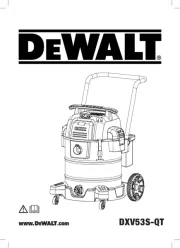
27 Augustus 2025
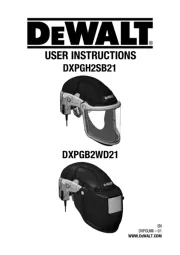
26 Augustus 2025
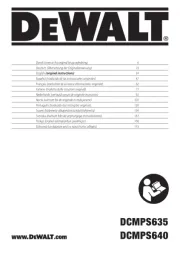
26 Augustus 2025
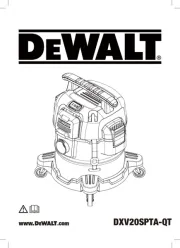
26 Augustus 2025
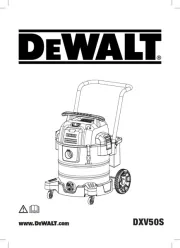
26 Augustus 2025
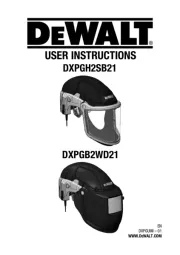
25 Augustus 2025
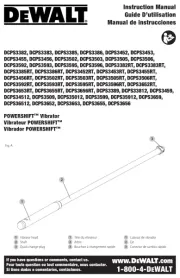
3 Augustus 2025
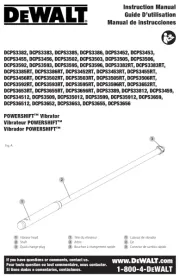
3 Augustus 2025
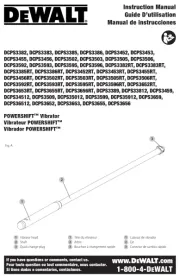
3 Augustus 2025
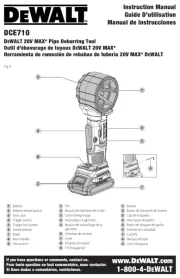
29 Juli 2025
Handleiding Niet gecategoriseerd
- Nec
- Dynaudio
- Maytronics
- IHome
- WHD
- Wacker Neuson
- Krüger&Matz
- Promise Technology
- Weetla
- Severin
- Rosco
- Rossi
- Gridbyt
- Orbsmart
- CyberChill
Nieuwste handleidingen voor Niet gecategoriseerd

14 September 2025

14 September 2025

13 September 2025

13 September 2025

13 September 2025

13 September 2025

13 September 2025

13 September 2025

13 September 2025

13 September 2025